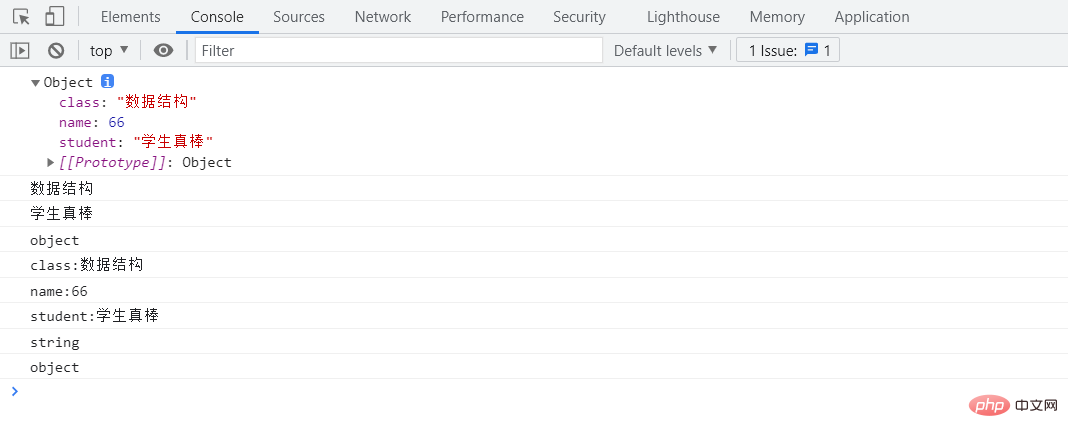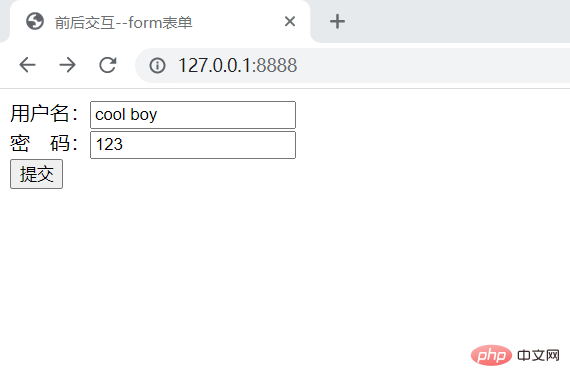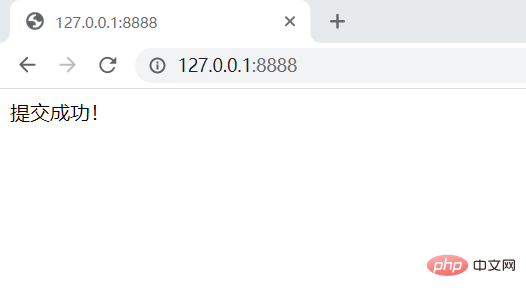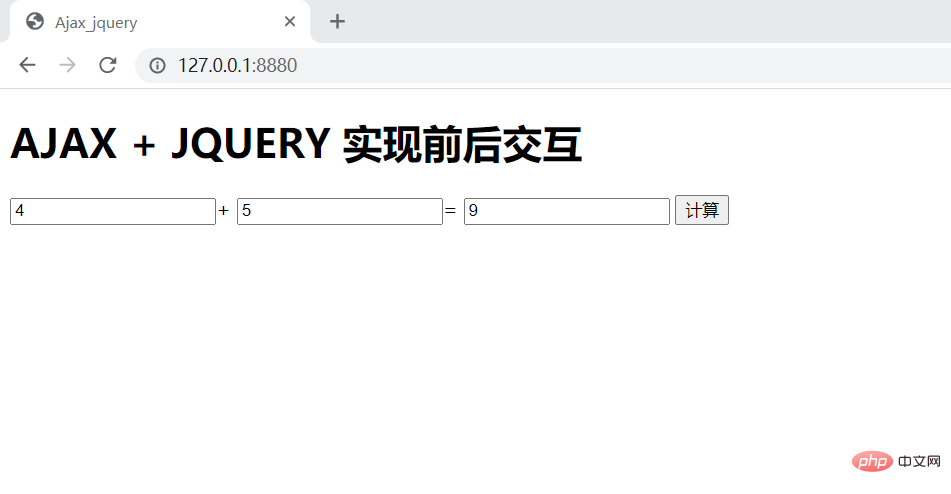 Web Front-end
Web Front-end
 Front-end Q&A
Front-end Q&A
 Let's briefly talk about the key points of Ajax before and after interaction
Let's briefly talk about the key points of Ajax before and after interaction
Let's briefly talk about the key points of Ajax before and after interaction
This article brings you relevant knowledge about ajax, including json, front and back interaction, etc. I hope it will be helpful to everyone.

Part 1: Introduction to JSON
##nbsp;html>
<meta>
<title>JSON</title><script>
//定义一个JSON对象
var obj = {
"class":"数据结构",
"name":66,
"student":65
};
//可读性
console.log(obj);
console.log(obj.class);
// 可写行
obj.student = "学生真棒";
console.log(obj.student);
console.log(typeof obj); //object 是一个json对象
// JSON遍历
for(var key in obj){
console.log(key + ":" + obj[key]);
}
// JSON对象转字符串
var obj1 = JSON.stringify(obj);
console.log(typeof obj1); //string
// 字符串转JSON对象
var obj2 = JSON.parse(obj1);
console.log(typeof obj2); //object</script>Copy after login
Effect display:
nbsp;html>
<meta>
<title>JSON</title><script>
//定义一个JSON对象
var obj = {
"class":"数据结构",
"name":66,
"student":65
};
//可读性
console.log(obj);
console.log(obj.class);
// 可写行
obj.student = "学生真棒";
console.log(obj.student);
console.log(typeof obj); //object 是一个json对象
// JSON遍历
for(var key in obj){
console.log(key + ":" + obj[key]);
}
// JSON对象转字符串
var obj1 = JSON.stringify(obj);
console.log(typeof obj1); //string
// 字符串转JSON对象
var obj2 = JSON.parse(obj1);
console.log(typeof obj2); //object</script>
One:
Tips:HTML code:import tornado.web
View its source code: 26-38 lines tornado version Hello world, just take it and change it~
nbsp;html>
<meta>
<title>前后交互--form表单</title>
Copy after login
Python code: nbsp;html> <meta> <title>前后交互--form表单</title>
import tornado.webimport tornado.ioloopimport tornado.webclass MainHandler(tornado.web.RequestHandler):
def get(self):
self.render("Ajax_form.html") #需要进行前后交互的HTML文件的路径
def post(self, *args, **kwargs): #此处的用post还是get取决于HTML文件中form表单的method属性(二者一样)
#通过打印在控制台进行查看,有没有成功从前端拿到信息
print(self.get_argument("user")) #.get_argument()拿到的是单个的参数,里面参数是form表单里name属性的属性值。
print(self.get_argument("pwd"))
self.write("提交成功!") if __name__ == "__main__":
application = tornado.web.Application([
(r"/", MainHandler), #需要和form表单里的action一致。
])
application.listen(8888) #端口号
tornado.ioloop.IOLoop.current().start()Copy after login
import tornado.webimport tornado.ioloopimport tornado.webclass MainHandler(tornado.web.RequestHandler):
def get(self):
self.render("Ajax_form.html") #需要进行前后交互的HTML文件的路径
def post(self, *args, **kwargs): #此处的用post还是get取决于HTML文件中form表单的method属性(二者一样)
#通过打印在控制台进行查看,有没有成功从前端拿到信息
print(self.get_argument("user")) #.get_argument()拿到的是单个的参数,里面参数是form表单里name属性的属性值。
print(self.get_argument("pwd"))
self.write("提交成功!") if __name__ == "__main__":
application = tornado.web.Application([
(r"/", MainHandler), #需要和form表单里的action一致。
])
application.listen(8888) #端口号
tornado.ioloop.IOLoop.current().start()Extension:How to implement:If Error: NotImplementedError
Read this article: https://blog.csdn.net/hank5658/article/details/106870245
First: run .py fileEffect display:After no error is reported, run the HTML file
Then change the address bar of the front-end interface to: 127.0.0.1:8888 and press Enter
If no error is reported, the forwarding is successful
Finally enter the user name and Password and click the submit button to display the username and password in the pycharm console.


 ## (2) Using AJAX Perform front-end and back-end interaction
## (2) Using AJAX Perform front-end and back-end interaction
- Ajax function?
- Using the form form for front-end and back-end interaction (traditional interaction mode) will refresh the entire page when submitting;
Using AJAX will perform
asynchronous loading
, and the entire page can be loaded without reloading Partial refresh under the premise. What is Ajax? - The full name is Ansync JavaScript and XML, which is an asynchronous loading technology with partial refresh.
- The use of Ajax is divided into two types: native and jq (Jquery). The native one is not very useful, so let’s talk about the JQ one below.
python code:
import tornado.webimport tornado.ioloopimport tornado.webclass MainHandler(tornado.web.RequestHandler):
def get(self):
self.render("ajax_jquery.html")
def post(self, *args, **kwargs):
aaa = int(self.get_argument("aa"))
bbb = int(self.get_argument("bb"))
c = aaa + bbb # 将后台处理过后的前端的数据回显到前端
return_data = {"result":c} #将需要传输的数据构造成JSON对象
self.write(return_data) #将后台需要传递给前端的数据回显给前端if __name__ == "__main__":
application = tornado.web.Application([
(r"/", MainHandler),
])
application.listen(8880) #端口号
tornado.ioloop.IOLoop.current().start()# windows 系统下 tornado 使用 SelectorEventLoopimport platformif platform.system() == "Windows":
import asyncio
asyncio.set_event_loop_policy(asyncio.WindowsSelectorEventLoopPolicy())
nbsp;html>
<meta>
<title>Ajax_jquery</title><h1 id="AJAX-JQUERY-实现前后交互">AJAX + JQUERY 实现前后交互</h1><input>+<input>=<input><button>计算</button><script></script> <!--要用网址引用--><script>
// 获取元素
var ipt = $("input");
var btn = $("#btn1");
btn.click(function () {
// 获取值
var a = ipt.eq(0).val(); //eq是获取下标对应的标签;val()是得到该标签内用户输入的值
var b = ipt.eq(1).val();
// 使用JQ里面封装好的Ajax方法将前端的数据传输给后端
$.ajax({
"type":"post", //数据传输的方式:post,get "url":"/", //提交的路径 "data":{ //键值对形式 传输的数据(需要传输到后台的数据) "aa":a,
"bb":b },
// 前后端成功之后的回调函数success Ajax请求发送成功后,自动执行此函数 "success":function (data2) { //callback==服务器write的数据
x = data2["result"];
ipt.eq(2).val(x); //将回显的数据放进前端指定的位置 },
// 失败之后的回调函数 "error":function (error) {
console.log(error);
}
})
})</script>Synchronization: After sending a request to the server, You need to wait for the server response to complete before sending the second request. If you send other requests without waiting for the server response to end, lag will occur.
Asynchronous: After sending a request to the server, you can send other requests directly without any interference between them. Partial refresh can be achieved.Effect display:
 [Related tutorial recommendations:
[Related tutorial recommendations:
The above is the detailed content of Let's briefly talk about the key points of Ajax before and after interaction. For more information, please follow other related articles on the PHP Chinese website!

Hot AI Tools

Undresser.AI Undress
AI-powered app for creating realistic nude photos

AI Clothes Remover
Online AI tool for removing clothes from photos.

Undress AI Tool
Undress images for free

Clothoff.io
AI clothes remover

Video Face Swap
Swap faces in any video effortlessly with our completely free AI face swap tool!

Hot Article

Hot Tools

Notepad++7.3.1
Easy-to-use and free code editor

SublimeText3 Chinese version
Chinese version, very easy to use

Zend Studio 13.0.1
Powerful PHP integrated development environment

Dreamweaver CS6
Visual web development tools

SublimeText3 Mac version
God-level code editing software (SublimeText3)

Hot Topics
 How to solve the 403 error encountered by jQuery AJAX request
Feb 20, 2024 am 10:07 AM
How to solve the 403 error encountered by jQuery AJAX request
Feb 20, 2024 am 10:07 AM
Title: Methods and code examples to resolve 403 errors in jQuery AJAX requests. The 403 error refers to a request that the server prohibits access to a resource. This error usually occurs because the request lacks permissions or is rejected by the server. When making jQueryAJAX requests, you sometimes encounter this situation. This article will introduce how to solve this problem and provide code examples. Solution: Check permissions: First ensure that the requested URL address is correct and verify that you have sufficient permissions to access the resource.
 How to solve jQuery AJAX request 403 error
Feb 19, 2024 pm 05:55 PM
How to solve jQuery AJAX request 403 error
Feb 19, 2024 pm 05:55 PM
jQuery is a popular JavaScript library used to simplify client-side development. AJAX is a technology that sends asynchronous requests and interacts with the server without reloading the entire web page. However, when using jQuery to make AJAX requests, you sometimes encounter 403 errors. 403 errors are usually server-denied access errors, possibly due to security policy or permission issues. In this article, we will discuss how to resolve jQueryAJAX request encountering 403 error
 PHP and Ajax: Building an autocomplete suggestion engine
Jun 02, 2024 pm 08:39 PM
PHP and Ajax: Building an autocomplete suggestion engine
Jun 02, 2024 pm 08:39 PM
Build an autocomplete suggestion engine using PHP and Ajax: Server-side script: handles Ajax requests and returns suggestions (autocomplete.php). Client script: Send Ajax request and display suggestions (autocomplete.js). Practical case: Include script in HTML page and specify search-input element identifier.
 How to solve the problem of jQuery AJAX error 403?
Feb 23, 2024 pm 04:27 PM
How to solve the problem of jQuery AJAX error 403?
Feb 23, 2024 pm 04:27 PM
How to solve the problem of jQueryAJAX error 403? When developing web applications, jQuery is often used to send asynchronous requests. However, sometimes you may encounter error code 403 when using jQueryAJAX, indicating that access is forbidden by the server. This is usually caused by server-side security settings, but there are ways to work around it. This article will introduce how to solve the problem of jQueryAJAX error 403 and provide specific code examples. 1. to make
 How to get variables from PHP method using Ajax?
Mar 09, 2024 pm 05:36 PM
How to get variables from PHP method using Ajax?
Mar 09, 2024 pm 05:36 PM
Using Ajax to obtain variables from PHP methods is a common scenario in web development. Through Ajax, the page can be dynamically obtained without refreshing the data. In this article, we will introduce how to use Ajax to get variables from PHP methods, and provide specific code examples. First, we need to write a PHP file to handle the Ajax request and return the required variables. Here is sample code for a simple PHP file getData.php:
 PHP vs. Ajax: Solutions for creating dynamically loaded content
Jun 06, 2024 pm 01:12 PM
PHP vs. Ajax: Solutions for creating dynamically loaded content
Jun 06, 2024 pm 01:12 PM
Ajax (Asynchronous JavaScript and XML) allows adding dynamic content without reloading the page. Using PHP and Ajax, you can dynamically load a product list: HTML creates a page with a container element, and the Ajax request adds the data to that element after loading it. JavaScript uses Ajax to send a request to the server through XMLHttpRequest to obtain product data in JSON format from the server. PHP uses MySQL to query product data from the database and encode it into JSON format. JavaScript parses the JSON data and displays it in the page container. Clicking the button triggers an Ajax request to load the product list.
 PHP and Ajax: Ways to Improve Ajax Security
Jun 01, 2024 am 09:34 AM
PHP and Ajax: Ways to Improve Ajax Security
Jun 01, 2024 am 09:34 AM
In order to improve Ajax security, there are several methods: CSRF protection: generate a token and send it to the client, add it to the server side in the request for verification. XSS protection: Use htmlspecialchars() to filter input to prevent malicious script injection. Content-Security-Policy header: Restrict the loading of malicious resources and specify the sources from which scripts and style sheets are allowed to be loaded. Validate server-side input: Validate input received from Ajax requests to prevent attackers from exploiting input vulnerabilities. Use secure Ajax libraries: Take advantage of automatic CSRF protection modules provided by libraries such as jQuery.
 What are the ajax versions?
Nov 22, 2023 pm 02:00 PM
What are the ajax versions?
Nov 22, 2023 pm 02:00 PM
Ajax is not a specific version, but a technology that uses a collection of technologies to asynchronously load and update web page content. Ajax does not have a specific version number, but there are some variations or extensions of ajax: 1. jQuery AJAX; 2. Axios; 3. Fetch API; 4. JSONP; 5. XMLHttpRequest Level 2; 6. WebSockets; 7. Server-Sent Events; 8, GraphQL, etc.





